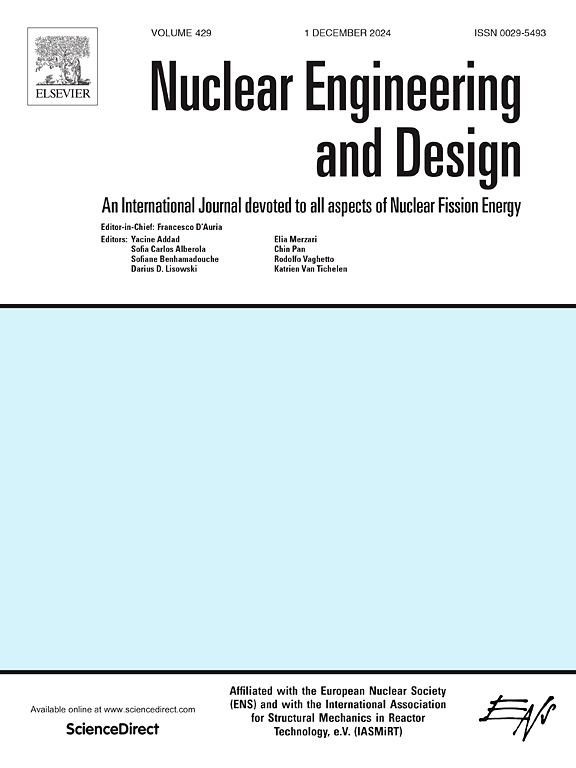High-temperature oxidation failure in reactivity-initiated accidents: An evaluation of failure criteria based on oxygen concentration from the previous NSRR experiments
IF 1.9
3区 工程技术
Q1 NUCLEAR SCIENCE & TECHNOLOGY
引用次数: 0
Abstract
For near-term application, coated-Zr alloy claddings show potential for enhancing safety by providing better oxidation resistance and minimizing hydrogen absorption under design-basis accidents (DBA). This benefit could extend the burnup and operational cycles of fuel rods. In assessing safety, reactivity-initiated accidents (RIA) are considered as one of the DBA conditions. The current safety criteria for high-temperature oxidation failure, one of the failure modes linked to RIA, are defined by peak fuel enthalpy values that range from 205 to 270 cal/g. This wide variability presents challenges when attempting to generalize criteria for modified-Zr alloy claddings with superior oxidation resistance. Therefore, it may be more relevant to apply failure criteria based on embrittlement mechanisms, such as oxygen concentration in the β-Zr phase. This study aimed to assess the failure based on both peak fuel enthalpy and cladding embrittlement by analyzing previous NSRR experiments conducted with conventional materials using the RANNS fuel performance code. The findings suggest that the failure criteria associated with cladding embrittlement can provide a rational evaluation of failure behavior compared to the existing criterion based on peak fuel enthalpy. The local failure criterion leading to the formation of through-wall cracks during quenching is consistent with Chung’s proposal (NUREG/CR-1344): β-Zr thickness of ≤ 0.9 wt% oxygen is less than 0.1 mm, and this corresponds to approximately 35 % BJ-ECR.
反应性引发事故中的高温氧化失效:基于先前NSRR实验中氧浓度的失效标准评估
在近期应用中,涂层zr合金包层在设计基础事故(DBA)下具有更好的抗氧化性和最大限度地减少氢吸收,具有提高安全性的潜力。这一优点可以延长燃料棒的燃耗和运行周期。在评估安全性时,反应性引发的事故(RIA)被认为是DBA条件之一。高温氧化失效是与RIA相关的失效模式之一,目前的安全标准是由205至270 cal/g的峰值燃料焓值定义的。当试图推广具有优异抗氧化性能的改性zr合金包层标准时,这种广泛的可变性提出了挑战。因此,应用基于脆性机制(如β-Zr相中的氧浓度)的失效准则可能更相关。本研究旨在通过分析以往使用RANNS燃料性能代码对传统材料进行的NSRR实验,评估基于峰值燃料焓和包层脆化的失效。研究结果表明,与现有的基于峰值燃料焓的失效准则相比,与包层脆化相关的失效准则可以提供合理的失效行为评估。在淬火过程中导致穿壁裂纹形成的局部失效准则与Chung的建议(NUREG/CR-1344)一致:β-Zr厚度≤0.9 wt%氧气小于0.1 mm,这相当于约35%的BJ-ECR。
本文章由计算机程序翻译,如有差异,请以英文原文为准。
求助全文
约1分钟内获得全文
求助全文
来源期刊

Nuclear Engineering and Design
工程技术-核科学技术
CiteScore
3.40
自引率
11.80%
发文量
377
审稿时长
5 months
期刊介绍:
Nuclear Engineering and Design covers the wide range of disciplines involved in the engineering, design, safety and construction of nuclear fission reactors. The Editors welcome papers both on applied and innovative aspects and developments in nuclear science and technology.
Fundamentals of Reactor Design include:
• Thermal-Hydraulics and Core Physics
• Safety Analysis, Risk Assessment (PSA)
• Structural and Mechanical Engineering
• Materials Science
• Fuel Behavior and Design
• Structural Plant Design
• Engineering of Reactor Components
• Experiments
Aspects beyond fundamentals of Reactor Design covered:
• Accident Mitigation Measures
• Reactor Control Systems
• Licensing Issues
• Safeguard Engineering
• Economy of Plants
• Reprocessing / Waste Disposal
• Applications of Nuclear Energy
• Maintenance
• Decommissioning
Papers on new reactor ideas and developments (Generation IV reactors) such as inherently safe modular HTRs, High Performance LWRs/HWRs and LMFBs/GFR will be considered; Actinide Burners, Accelerator Driven Systems, Energy Amplifiers and other special designs of power and research reactors and their applications are also encouraged.
 求助内容:
求助内容: 应助结果提醒方式:
应助结果提醒方式:


